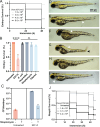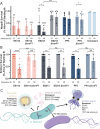This is a preprint.
A mutualistic model bacterium is lethal to non-symbiotic hosts via the type VI secretion system
- PMID: 39713446
- PMCID: PMC11661226
- DOI: 10.1101/2024.12.13.628426
A mutualistic model bacterium is lethal to non-symbiotic hosts via the type VI secretion system
Update in
-
A mutualistic model bacterium is lethal to non-symbiotic hosts via the type VI secretion system.mBio. 2025 May 14;16(5):e0015725. doi: 10.1128/mbio.00157-25. Epub 2025 Apr 17. mBio. 2025. PMID: 40243333 Free PMC article.
Abstract
What makes a bacterium pathogenic? Since the early days of germ theory, researchers have categorized bacteria as pathogens or non-pathogens, those that cause harm and those that do not, but this binary view is not always accurate. Vibrio fischeri is an exclusive mutualistic symbiont found within the light organs of Hawaiian bobtail squid. This symbiotic interaction requires V. fischeri to utilize a range of behaviors and produce molecules that are often associated with pathogenicity. This juxtaposition of employing "pathogenic" behaviors for a symbiotic relationship led the field to focus on how V. fischeri establishes a beneficial association with its host. In this study, we observe that V. fischeri induces mortality in zebrafish embryos and Artemia nauplii. Non-lethal doses of V. fischeri leads to zebrafish growth delays and phenotypes indicative of disease. Our data also provide evidence that the conserved type VI secretion system on chromosome I (T6SS1) plays a role in the V. fischeri-induced mortality of zebrafish embryos and Artemia nauplii. These results support the hypothesis that the V. fischeri T6SS1 is involved in eukaryotic cell interactions. Despite its traditional view as a beneficial symbiont, we provide evidence that V. fischeri is capable of harming aquatic organisms, indicating its potential to be pathogenic toward non-symbiotic hosts.
Keywords: Pathogenicity; Type IV Secretion System; V. fischeri; Zebrafish.
Conflict of interest statement
Competing interests: The authors declare no competing interest.
Figures


Similar articles
-
A mutualistic model bacterium is lethal to non-symbiotic hosts via the type VI secretion system.mBio. 2025 May 14;16(5):e0015725. doi: 10.1128/mbio.00157-25. Epub 2025 Apr 17. mBio. 2025. PMID: 40243333 Free PMC article.
-
The type-VI secretion system of the beneficial symbiont Vibrio fischeri.Microbiology (Reading). 2023 Feb;169(2):001302. doi: 10.1099/mic.0.001302. Microbiology (Reading). 2023. PMID: 36809081 Free PMC article. Review.
-
Colonization of Euprymna scolopes squid by Vibrio fischeri.J Vis Exp. 2012 Mar 1;(61):e3758. doi: 10.3791/3758. J Vis Exp. 2012. PMID: 22414870 Free PMC article.
-
Ambient pH Alters the Protein Content of Outer Membrane Vesicles, Driving Host Development in a Beneficial Symbiosis.J Bacteriol. 2019 Sep 20;201(20):e00319-19. doi: 10.1128/JB.00319-19. Print 2019 Oct 15. J Bacteriol. 2019. PMID: 31331976 Free PMC article.
-
The Role of Hemocytes in the Hawaiian Bobtail Squid, Euprymna scolopes: A Model Organism for Studying Beneficial Host-Microbe Interactions.Front Microbiol. 2017 Jan 6;7:2013. doi: 10.3389/fmicb.2016.02013. eCollection 2016. Front Microbiol. 2017. PMID: 28111565 Free PMC article. Review.
References
-
- Sampaio A., Silva V., Poeta P., Aonofriesei F., Vibrio spp.: Life strategies, ecology, and risks in a changing environment. Diversity 14, 97 (2022).
-
- Koropatnick T. A., et al. Microbial factor-mediated development in a host-bacterial mutualism. Science 306, 1186–1188 (2004). - PubMed
Publication types
Grants and funding
LinkOut - more resources
Full Text Sources
